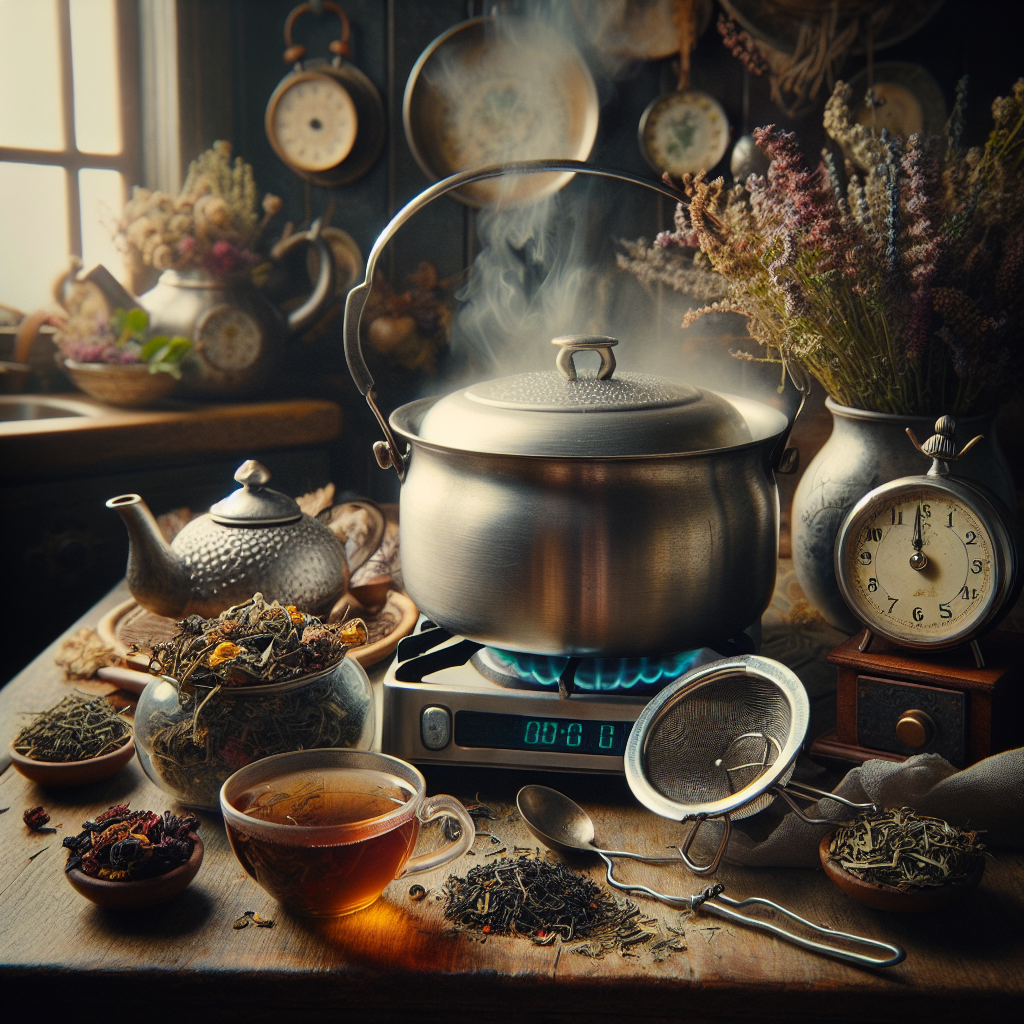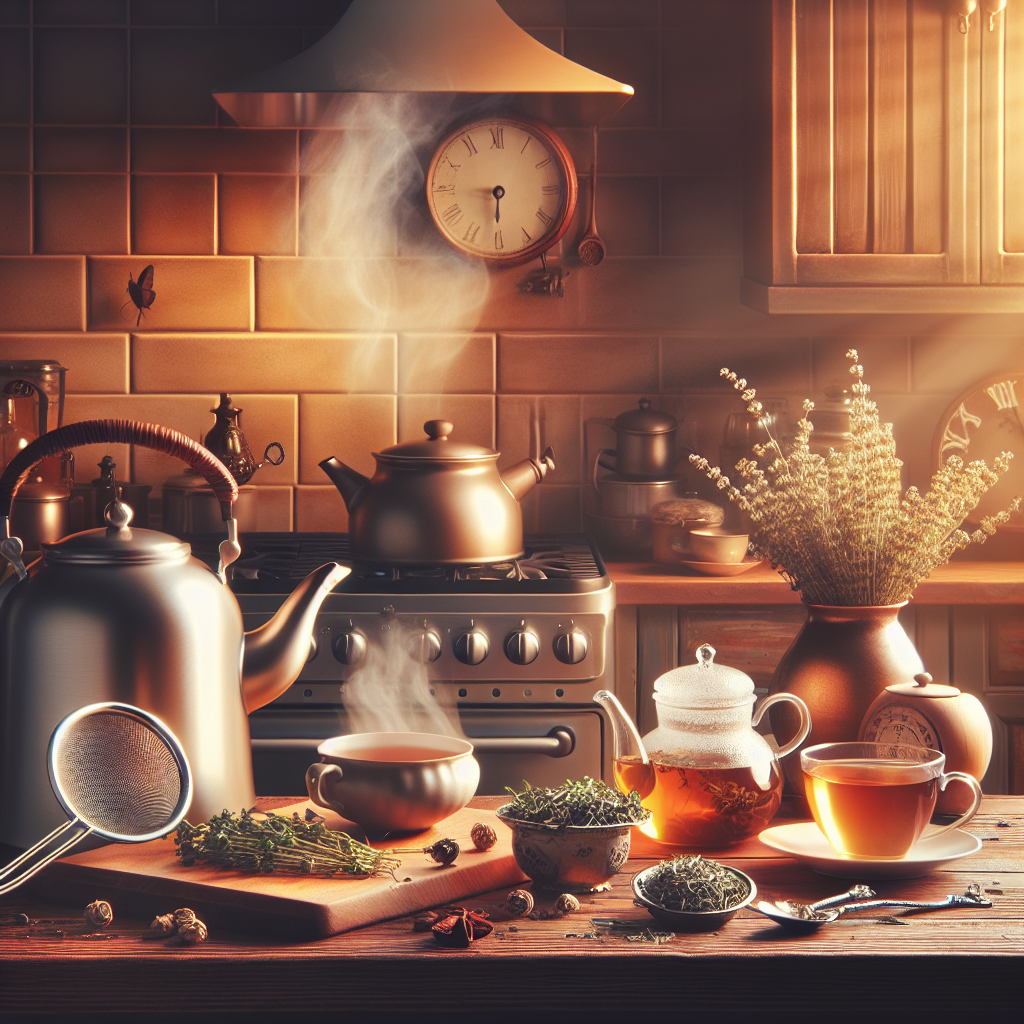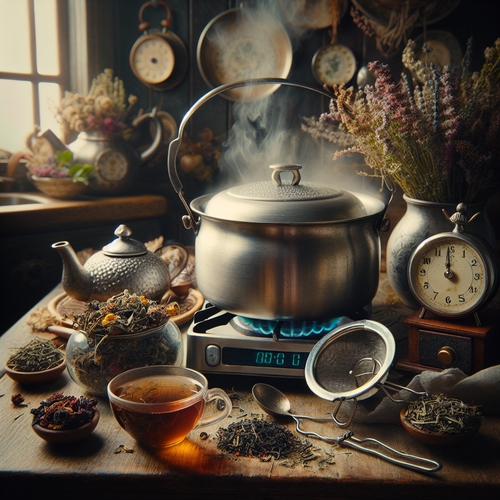The Hidden Science of Tea Brewing: How Water Temperature Changes Healing Power
Posted by Education Team @1st Chinese Herbs on Oct 11th 2025
The Hidden Science of Tea Brewing: How Water Temperature Changes Healing Power
Brew smarter, not hotter. Learn how water temperature unlocks (or ruins) the active compounds in teas and herbs—plus folklore, step-by-steps, and pro tips.
Quick Summary Of Brewing Tea
-
Different compounds extract at different temperatures (think: catechins, theanine, caffeine, essential oils, polysaccharides).
-
Too hot = harsh, bitter, volatile oils blown off; too cool = under-extracted, weak benefits.
-
Match plant part + purpose to the right temperature & time: delicate leaves/flowers like cooler water; roots/barks/seeds usually need hotter water or a decoction (simmer).
-
Small changes—10–15°F (5–8°C)—can transform flavor and function.

Table of Contents
-
Why Temperature Matters (the extraction science)
-
The “Compound Map” of Tea & Herbs
-
Temperature Ranges by Tea Type (Green → Pu-erh)
-
Temperature Ranges by Herbal Category (Leaves, Flowers,
-
Roots/Barks/Seeds)
-
Gongfu,
-
“Fish Eyes,” and Folklore: How Ancients Gauged Heat
-
Practical Methods (no thermometer needed), Altitude & Water Quality
-
Step-by-Step: Choose Your Goal → Pick the Brew
-
Real-World Results (anonymized customer stories)
-
Troubleshooting & Pro Tips
1) Why Temperature Matters (the extraction science)
Plants contain families of compounds with different solubility and stability thresholds:
-
Amino acids (L-theanine), simple sugars → extract well at 150–175°F (65–80°C); give sweetness/umami and smooth mouthfeel.
-
Catechins/polyphenols & caffeine → need hotter water to fully extract (175–205°F | 80–96°C), but overshooting can increase harshness.
-
Volatile oils (mint, chamomile, chrysanthemum, citrus peel) → aroma lifts at 160–185°F (70–85°C); rolling boils can drive them off.
-
Polysaccharides, saponins & some alkaloids in roots/barks/seeds (e.g., astragalus, licorice, burdock, cinnamon) → often need near-boiling or gentle simmer (decoction) to extract well.
Bottom line: temperature selects which compounds dominate your cup—flavor and function shift with the dial.
2) The Compound Map (what heat unlocks)
| Compound Group | Examples | What Heat Does | Taste Impact |
|---|---|---|---|
| Amino acids | L-theanine (tea) | Better at lower temps; preserves calm, sweet umami | Sweeter, rounder |
| Polyphenols (catechins, theaflavins) | Green/black tea antioxidants | Need hotter temps; too hot → astringent/bitter | Briskness, structure |
| Caffeine | All camellia teas | ↑ with heat/time; cold brew extracts less | Energy/“lift” |
| Essential/volatile oils | Peppermint, chamomile, chrysanthemum | Evaporate if boiled hard | Aroma & calm |
| Polysaccharides/saponins | Astragalus, licorice, reishi, burdock | Require high heat/longer simmer | Body, “brothy” feel |
3) Temperature Ranges by Tea Type (Camellia sinensis)
| Tea | Water Temp | Time | Notes |
|---|---|---|---|
| Green (Sencha, Longjing) | 160–175°F (70–80°C) | 1–3 min | Cooler keeps it sweet/umami; hotter = bitter. |
| White (Bai Mudan, Silver Needle) | 175–185°F (80–85°C) | 2–4 min | Delicate buds—avoid boiling. |
| Oolong (Tieguanyin, Dancong) | 185–205°F (85–96°C) | 1–3 min | Complex aromatics; multiple infusions (Gongfu). |
| Black/Red (Assam, Dianhong) | 200–212°F (93–100°C) | 2–4 min | Brisk; boiling okay; avoid over-steep. |
| Pu-erh (Sheng/Shou) | 200–212°F (93–100°C) | 10–20s (Gongfu) or 3–5 min | Rinse leaves; multiple short infusions shine. |
4) Temperature by Herbal Category
| Category | Examples | Method | Temp & Time |
|---|---|---|---|
| Leaves (aromatic, delicate) | Mint, lemongrass, mulberry leaf | Infusion | 175–190°F (80–88°C), 5–10 min |
| Flowers | Chrysanthemum, chamomile, honeysuckle | Infusion (cover cup to trap oils) | 170–185°F (77–85°C), 5–10 min |
| Fruits/Peels | Goji, hawthorn, tangerine peel | Infusion or gentle simmer | 190–205°F (88–96°C), 10–20 min |
| Roots/Barks/Seeds | Astragalus, burdock, cinnamon, licorice, fennel | Decoction (simmer) | Light simmer 20–30 min; top up water as needed |
| Fungi | Reishi, turkey tail | Decoction | Gentle simmer 30–60 min |
Tip: If using mixed formulas, start with a decoction for roots/barks/fungi, then add leaves/flowers in the last 3–5 minutes to protect aromatics.
5) Folklore & Traditional Heat Cues
-
Gongfu tea (China): water is judged by boil stages—
“Shrimp eyes” (tiny bubbles), “crab eyes” (growing), “string of pearls” (rising bubbles). Each stage aligns with a different steep for fragrance vs strength. -
Japanese sencha: cooler water is prized for umami and calm clarity; masters cool water in a yuzamashi bowl before pouring.
-
TCM wisdom: warm, not scalding, is kinder to the Spleen/Stomach; very cold or very hot extremes may disrupt balance.
6) Practical Methods (with or without a thermometer)
No thermometer? Try these:
-
Boil-then-rest method:
-
Boil water → open kettle lid → wait 1 min ≈ ~200°F (93°C); 2–3 min ≈ 185–190°F (85–88°C); 5 min ≈ 175°F (80°C).
-
-
Two-cup cool: Pour boiling water into an empty mug, then into your teapot. Each transfer drops ~5–10°F (3–6°C).
-
Altitude matters: Water boils at lower temps at higher elevations; you may need longer time rather than more heat.
-
Water quality: Moderate mineral content (hardness) improves body; very soft water tastes flat; chlorine mutes aromatics—filter if needed.
-
Vessel: Clay retains heat; glass cools faster; thin porcelain gives control for delicate teas.
 7) Step-by-Step: Choose Your Goal → Pick the Brew
7) Step-by-Step: Choose Your Goal → Pick the Brew
Goal A: Calm clarity without bitterness (afternoon focus)
-
Tea: High-grade green or lightly oxidized oolong
-
Temp/Time: 170°F (77°C), 2 min → taste; re-infuse 2–3x
-
Why: Preserves L-theanine and aromatics; curbs harsh catechins/caffeine spike.
Goal B: Comforting, full-bodied cup (evening wind-down, caffeine-light)
-
Herb: Chrysanthemum + goji berries
-
Temp/Time: 180–185°F (82–85°C), 8–10 min, covered
-
Why: Keeps floral oils intact; gentle sweetness from goji.
Goal C: Deep extraction from roots/barks (brothy, supportive)
-
Herb: Astragalus slices + licorice slice
-
Method: Decoction—simmer 25–30 min, strain; sip warm
-
Why: Polysaccharides & saponins need time/heat.
Goal D: Aroma-forward mint that doesn’t taste “boiled”
-
Herb: Peppermint leaf
-
Temp/Time: 180°F (82°C), 5–7 min, covered
-
Why: Avoids volatilizing menthol; brighter, sweeter cup.
8) Real-World Results
“Switching my green tea from boiling to 170°F made it sweet instead of bitter—now I actually finish the cup.” — L.M., Oregon
“I used to ‘boil’ chamomile. At 180°F with a lid, it smells like a garden and I sleep better with the ritual.” — S.J., Washington
“Astragalus never did much for me until I simmered it 30 minutes. The broth-like feel is totally different.” — R.K., Texas
(Shared with permission; experiences vary. Educational use only.)
9) Troubleshooting & Pro Tips
-
Too bitter/astringent? Lower temp by 10–15°F or shorten by 30–60 sec.
-
Too weak? Increase temp slightly or extend time in small steps; for roots, consider a decoction.
-
Flat flavor? Check water quality; try filtered water or a different vessel.
-
Aroma missing? Cover while steeping to trap volatile oils.
-
Mixed blends (roots + leaves): Stagger—decoct roots first, add leaves right at the end.
10) FAQ
Q: Can I cold-brew herbs?
Yes, for aromatic leaves/fruits (8–12 hrs in the fridge). It’s lower in caffeine/bitterness but extracts fewer heavy compounds than hot water.
Q: Is hotter always “more potent”?
Not necessarily. Potent ≠ pleasant. Excess heat can destroy aromatics and over-extract tannins, which may discourage consistent use.
Q: Mug vs teapot?
Teapots (especially clay/ceramic) stabilize temperature for repeatable results; mugs cool quickly, which can be good for delicate teas.
Tea Trivia
1. What happens if you brew green tea with boiling water (212°F / 100°C)?
A) It becomes sweeter and more aromatic
B) It turns bitter and loses delicate amino acids
C) It releases more antioxidants safely
D) It tastes the same at any temperature
✅ Correct Answer: B
2. Which tea benefits most from near-boiling water (200–212°F)?
A) White tea
B) Green tea
C) Black or Pu-erh tea
D) Jasmine tea
✅ Correct Answer: C
3. In Traditional Chinese Medicine, why are extremely hot or cold drinks discouraged?
A) They dull the taste buds
B) They upset the balance of the Spleen and Stomach Qi
C) They make caffeine stronger
D) They slow digestion permanently
✅ Correct Answer: B
4. What is the ideal brewing temperature range for delicate herbs like chrysanthemum or chamomile?
A) 140–150°F (60–65°C)
B) 160–175°F (70–80°C)
C) 180–190°F (82–88°C)
D) Boiling water only
✅ Correct Answer: C
5. According to traditional folklore, what are “shrimp eyes” and “crab eyes”?
A) Stages of water temperature during boiling
B) Marks left on teapots from use
C) Bubbles from cold water
D) Tea leaf shapes
✅ Correct Answer: A
Final Thought
Tea brewing isn’t just a habit—it’s chemistry, mindfulness, and tradition poured into one cup. When you learn to control temperature, you don’t just change the flavor; you unlock the herb’s full character, energy, and spirit. The next time you brew, slow down, watch the steam, and remember: healing begins the moment the water meets the leaf.
Written by Sarah Johnson, M.S. in Holistic Healing and founder of 1st Chinese Herbs. Since 1994, she has educated consumers on Traditional Chinese Medicine and safe, effective herbal use.
Lab-Tested | GMP Certified | Since 1994 | Educational Content Only
References
-
“Effects of brewing conditions on antioxidant levels in tea” (PubMed PMID: 30107890)
-
“Temperature influence on catechin extraction from green tea” (PMID: 32484171)
-
“Impact of brewing temperature on flavor compounds in herbal infusions” (ScienceDirect)
Add these as footnotes or hyperlinked phrases like (PubMed study) for transparency.

